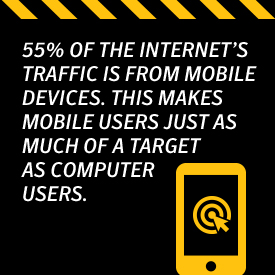Mobile scams: How to identify them and protect yourself
Mobile scams and malware are on the rise, and scammers are evolving to get smarter at tricking you into giving up your data. Review the many different types of mobile scams below and the best ways to identify them and keep your data safe.

Identity Theft is one of the most dangerous threats on the Internet Landscape. If a cybercriminal gains access to your financial information, it can be a potential catastrophe. In this post we’ll outline how you can keep your personal data protected from prying eyes.

Help protect your digital life on your devices.
Are you afraid of losing your personal information or all the precious things on your computer? Get comprehensive protection with Norton Security Deluxe across all your devices – up to 5 PCs, Macs, smartphones or tablets.
Create an account today and try it free for 30 days on up to 5 of your devices.
In today’s world, much of Internet’s traffic is from mobile devices. This makes mobile users just as much of a target as computer users. Mobile scams and malware are on the rise, and scammers are evolving to get smarter at tricking you into giving up your data. Review the many different types of mobile scams below and the best ways to identify them and keep your data safe.
Malware Apps
With copycat apps increasing on official app stores, it’s harder than ever to know whether an app you’re downloading is genuine. Outside of the big, trusted names, how do you know if an unknown developer with few reviews is really making useful apps, or simply building vehicles for getting malware onto your smartphone?

Ways You Can Spot A Fake Mobile App:
- Do some research. Even if the developer seems to have few reviews or very little downloads, they could just be starting out. On the other hand, they can be a scammer intent on tricking you into downloading the app. Perform an Internet search on the app and the developer. Most legitimate developers will have a website that showcases the app and any additional apps that company has made.
- Read what reviews of the app that are available. If they seem short and nondescript, chances are, it is a scam. Additionally, there could also be reviews from users that were previously duped by that app.
- Notice the details. Are the images of the app professional? Good design indicates a good app. Scammers are often in a rush and simply throw images together. Look for mismatched fonts, misspellings and non-symmetrical placement of logos and images.
- Are there thorough explanations and details of what the app does? Legitimate app developers will usually write out a good explanation of instructions and features of the app.
- Many fake apps are clones of popular, established apps. Examine the name of the developer to see if it matches up with the app. Note the amount of reviews- hugely popular apps will have hundreds, if not thousands of user reviews.
To add an extra layer of reassurance when browsing for new apps, download Norton Mobile Security and use it to scan new apps before you run them – you might be surprised what you find out.
Social Media Spam
If you’re on Twitter you know how annoying it is to be followed by a garbled name with zero followers, then receive a tweet with little more than a link. Facebook is full of fake profiles, some of which have innocent intentions, but most are there to provide fake Likes on demand – or to spam genuine users with phishing links. However convincing a message may be, never click on a link sent by a stranger or send money. Even if it seems harmless enough at the time, you could end up either giving your valuable personal details to a criminal, or – worse – have malware inserted onto your mobile.
SMS Phishing (Smishing)
The same applies over old-fashioned SMS, with messages arriving from unknown numbers urging you to reply to a number or to click on a link and open it in your phone’s browser. Again, doing so may be harmless, but will more likely insert malware onto your phone – or at least alert scammers to the fact that your number is active and worth targeting again.
These scams can present themselves in many forms. Examples include misleading offers such as “free” ringtones, sweepstakes offers, something else that sounds too good to be true, or a pressing matter from your bank or financial institution.
There’s a few ways scammers can get you with ringtone scams. Sometimes those “free” ringtones are an actual subscription service, and if you respond you’re unknowingly signed up for the service. Other times, they come embedded with malware. To be safe, only get your ringtones from reputable sources such as the Google Play Store or the iTunes Store.
SMS phishing will use some sort of scare tactic to get a quick reply without much time to think about the action. When in the form of a notice from a bank or financial institution, the phisher requests immediate action or your account will be closed. If you feel your accounts are in danger, look up the company’s customer service phone number online and call them to verify the text.
How to stay safe:
- Use caution when clicking on links sent to you via SMS when coming from unknown senders. You can always Google the sender’s phone number and if it is a scam, there will be multiple reports of the scam online.
- Don’t respond to text messages from numbers that are not complete cell phone numbers (Such as 5000). These kinds of messages are from email to text services, which are popular amongst scammers.
- Don’t respond to text messages without verifying who the sender is (again, Google is your friend in this case).
- Don’t call a phone number from an unknown text. This can incur high charges on your phone bill that you won’t be aware of.
- Use caution on free offers or notifications of winning a prize. If the offer sounds too good to be true, it probably is.
Vishing
Voice phishing – or vishing – has a human element, and it takes many forms. A scammer might call pretending to be your bank, ask for your security details and PIN number, and inform you that your card has been compromised and a courier will be arriving soon with a replacement. Of course, the replacement is a fake, and the scammer gets away with your genuine card and security details. Even without the physical element, simple voice phishing for login details is common, and surprisingly effective. Your bank will never ask for your PIN, so never give it to anyone that does ask. If you do receive an unexpected call from your bank, tell them you’ll call them back before giving any security details.
One Ring Scams
With this scam, the scammer will call once and hang up, with the objective of luring you into calling the number back. These numbers can be high toll lines, and by calling them you can end up paying a premium rate for the phone call.
Although mobile malware is on the rise, you can keep yourself protected by being smart about what actions you perform on your phone. The first line of defense against cyber attacks is the user. Educate yourself by utilizing the tips mentioned in this article. In addition to knowledge, you can add an extra layer of protection to your phone by installing Norton Security, which can help protect you against the endless number of threats on the mobile Internet landscape.
Editorial note: Our articles provide educational information for you. Our offerings may not cover or protect against every type of crime, fraud, or threat we write about. Our goal is to increase awareness about Cyber Safety. Please review complete Terms during enrollment or setup. Remember that no one can prevent all identity theft or cybercrime, and that LifeLock does not monitor all transactions at all businesses. The Norton and LifeLock brands are part of Gen Digital Inc.





Want more?
Follow us for all the latest news, tips and updates.